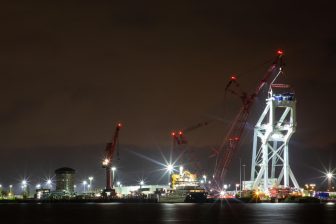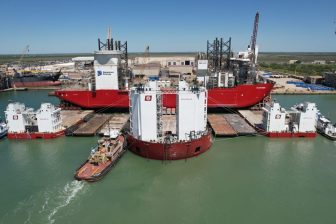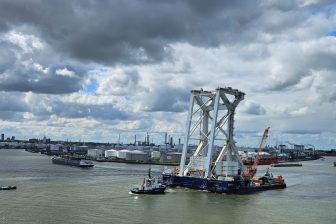![[VIDEO] Hollandse Kust Zuid construction progressing](https://www.projectcargojournal.com/wp-content/uploads/2021/09/VIDEO-Hollandse-Kust-Zuid-construction-progressing-480x300.jpg)
[VIDEO] Hollandse Kust Zuid construction progressing
The offshore construction of the Hollandse Kust Zuid wind farm started at the beginning of July, and is progressing at full speed. Every few days, Seaway 7‘s Strashnov docks at the Sif Group yard in Rotterdam to pick up sets of foundations and secondary steel components to be installed at sea.
As foundation installation manager at Vattenfall, Malte Röder said, “We started with the design for the installation tools and methodology, and together with the offshore installation company Seaway 7, we worked towards a suitable concept for the installation of our foundations.”
To guarantee efficient use of materials such as steel, each foundation is designed specifically for the location where it will be installed. The heaviest and largest monopile weighs 955 tonnes and is 75 metres long, while the lightest and shortest foundation still weighs 735 tonnes and measures 62 metres. The monopiles will be installed in water depths varying from 17 to 28 metres.
Rough weather conditions
While smaller parts for Hollandse Kust Zuid are stored in and transported from the IJmuiden harbour, the foundations and secondary steel components are shipped from foundation manufacturer Sif’s yard on the Maasvlakte area in the Rotterdam harbour using the installation vessel Seaway Strashnov. The ship has a crane that lifts the monopile foundation into the water and lowers it until it reaches the seabed. Once the foundation is in position on the seabed, a hydraulic impact hammer is used to drive the pile to the final penetration depth.
“We will install as many foundations as we can until we will take a scheduled break in the fall. Then the weather conditions on the North Sea will be too rough to work. During the break we will work to improve and optimise our work procedures even further to ensure that the installation of the remaining monopiles will run as smoothly as possible next year,” Röder said.
Lessons learned
The first series of foundations and secondary steel components have now been installed and have already provided some valuable lessons for the rest of the installation campaign.
“One of the lessons we took from this first series of installations is that a couple of bolts and nuts did not work quite as they should,” Malte Röder says. “These kind of practicalities are now popping up because previously we mostly focused on the big parts fitting together. With the construction being far away from shore, you do not just bring new bolts to the construction site. We also have to make sure that other type of bolts have the same lifespan as the rest of the foundation. Plus, everything is so big that you cannot just buy parts in the store.”
“We have also made some improvements already to the preparation of the workplaces. Construction technicians need to have their equipment right next to them, so that they do not need to search for the right tools. It is details like this that you come across when you actually go into construction,” he said.
You just read one of our premium articles free of charge
Register now to keep reading premium articles.




